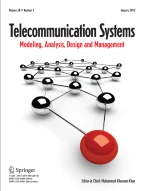Abstract
Peer-to-peer (P2P) networking technology has gained popularity as an efficient mechanism for users to obtain free services without the need for centralized servers. Protecting these networks from intruders and attackers is a real challenge. One of the constant threats on P2P networks is the propagation of active worms. Recent events show that active worms can spread automatically and flood the Internet in a very short period of time. Therefore, P2P systems can be a potential vehicle for active worms to achieve fast worm propagation in the Internet. Nowadays, BitTorrent is becoming more and more popular, mainly due its fair load distribution mechanism. Unfortunately, BitTorrent is particularly vulnerable to topology aware active worms. In this paper we analyze the impact of a new worm propagation threat on BitTorrent. We identify the BitTorrent vulnerabilities it exploits, the characteristics that accelerate and decelerate its propagation, and develop a mathematical model of their propagation. We also provide numerical analysis results. This will help the design of efficient detection and containment systems.
Similar content being viewed by others
Explore related subjects
Discover the latest articles, news and stories from top researchers in related subjects.References
Androutsellis-Theotokis, S., & Spinellis, D. (2004). A survey of peer-to-peer content distribution technologies. ACM Computing Surveys, 36(4), 371.
Cohen, B. (2003). Incentives build robustness in BitTorrent. Workshop on economics of peerto-peer systems (Vol. 6). Citeseer.
Ipoque (2007). P2P survey.
Dale, C., & Liu, J. (2007). A measurement study of piece population in BitTorrent. Washington: GlobeCom.
Yu, W., Boyer, C., Chellappan, S., & Xuan, D. (2005). Peer-to-peer system-based active worm attacks: modeling and analysis. In IEEE international conference on communications (ICC). May 2005.
Göldi, C., & Hiestand, R. (2005). Scan detection based identification of worm infected hosts. Zurich: Swiss Federal Institute of Technology. ETHZ, 18 April 2005.
Hales, D., & Patarin, S. (2005). How to cheat BitTorrent and why nobody does. s.l.: TR UBLCS-2005-12, Department of Computer Science University of Bologna, May 2005.
Erman, D., et al. (2004). Measurement and analysis of BitTorrent signaling traffic. NTS17, Oslo, 2004.
Joukov, N., & Chiueh, T. (2003). Internet worms as internet-wide threat. Tech. rep. TR-143, Experimental Computer Systems Lab, September 2003.
Abhishek, S., & Vijay, E. Worms: attacks, defense and models. s.l.: Computer Science Department, University of Southern California.
Khiat, N., Carlinet, Y., & Agoulmine, N. (2006). The emerging threat of peer-to-peer worms. In MonAM 2006 workshop.
Theory.org. BitTorrent protocol specification v1.0. http://wiki.theory.org/BitTorrentSpecification.
Pouwelse, J. A., et al. (2005). The BitTorrent P2P file-sharing system: measurements and analysis. International workshop on peer-to-peer systems (IPTPS).
Chen, Z. S., Gao, L. X., & Kwiat, K. (2003). Modeling the spread of. In Proceedings of IEEE INFOCOM. San Francisco, March 2003.
Tao, L., Zhihong, G., & Wu, X. (2007). Modeling and analyzing the spread of active worms based on P2P systems. Computers & Security, 26(3), 213–218.
Joukov, N., & Chiueh, T. (2003). Internet worms as internet-wide threat. Tech. rep. TR-143, Experimental Computer Systems Lab, Staniford, Stuart, Paxson, Vern and Weaver, Nicholas, September 2003.
How to own the Internet in your spare time. In Proceedings of the 8th USENIX security symposium, August 2002.
Richardson, R. (2007). 2007 CSI computer crime and security survey. s.l.: Computer Security Institute.
Author information
Authors and Affiliations
Corresponding author
Rights and permissions
About this article
Cite this article
Hatahet, S., Bouabdallah, A. & Challal, Y. A new worm propagation threat in BitTorrent: modeling and analysis. Telecommun Syst 45, 95–109 (2010). https://doi.org/10.1007/s11235-009-9241-2
Published:
Issue Date:
DOI: https://doi.org/10.1007/s11235-009-9241-2
